
Canadian parents were asked about their involvement in their children’s physical activity and sport activities in the Canadian Fitness and Lifestyle Research Institute’s 2022 Parent Survey of the Physical Activity and Sport Participation among 5 to 17 year olds. The types of involvement ranged considerably from active involvement by participating in games or sport with the child through to more passive involvement such as encouraging their child to play outdoors.
Many parents often or very often encouraged their children to play outdoors regularly or participate in active play over screen-based activities (69%). Considerably fewer parents often or very often played active games or sport with their children (28%).
More than two-third of parents (69%) stated that they often or very often encouraged their child to play outdoors regularly or encouraged their children to participate in active play over screen based-activities, while 22%-23% sometimes have. Only 6% of parents reported that they never or rarely encouraged these behaviours in their child, and 2% said that they did not during the pandemic. Roughly half of parents (52%) said that they often or very often place limits on the amount of time that their child spends on screen-based activities, whereas an additional 27% sometimes have. Almost one in five parents (19%) have never or rarely done this, and 3% had not placed such limits due to the pandemic.
Figure 1: Parental involvement in children’s physical activities and sport
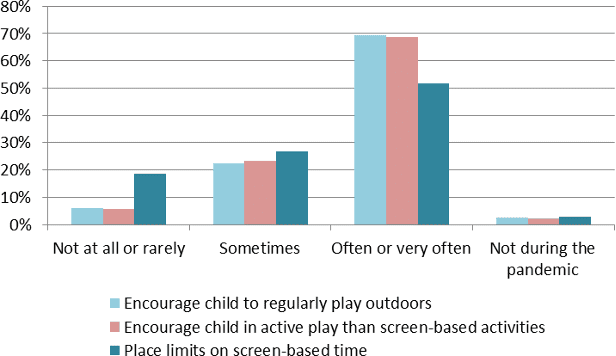
Source: 2022 Parent Survey of the Physical Activity and Sport Participation among 5 to 17 year olds, CFLRI
Approximately half (51%) of parents indicated that they often or very often transport their child to places so that they could participate in physical activity or sport, 28% mentioned that they sometimes have, 15% said that they have never or rarely done this, and a further 7% stated that they did not do so during the COVID-19 pandemic. In addition, 50% of parents responded that they often or very often watch or spectate when their child participated in physical activity or sport, and a further 27% stated that they sometimes have. Moreover, 15% of parents have never or rarely watched their child’s activities, and 8% did not do so during the pandemic.
Figure 2: Parental involvement in children’s physical activities and sport
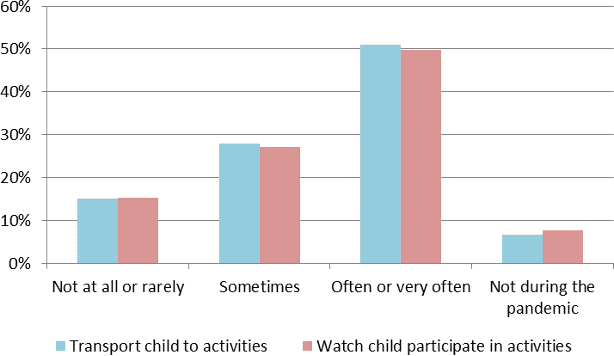
Source: 2022 Parent Survey of the Physical Activity and Sport Participation among 5 to 17 year olds, CFLRI
Just over one-quarter of parents (28%) reported that they often or very often play active games or sport with their children, while 44% indicated that they sometimes have. Roughly one-quarter (26%) of parents have rarely or never played active games or sport with their child. A further 2% of parents said that they did not do this doing the pandemic.
Figure 3: Parental involvement in children’s physical activities and sport
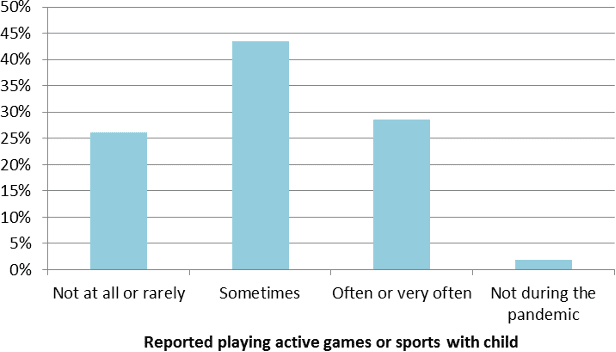
Source: 2022 Parent Survey of the Physical Activity and Sport Participation among 5 to 17 year olds, CFLRI
Parents of younger children (aged 5 to 11 years) reported more frequent involvement with their children’s active behaviours compared to parents of youth (aged 12 to 17 years).
Compared to parents of 12 to 17 year olds, a greater percentage of parents of 5 to 11 year olds reported that they have often or very often:
- played active games or sport with their child (23% versus 35%, respectively);
- spectated or watched their child participate (46% versus 54%);
- encouraged their child to play outdoors regularly (66% versus 73%);
- encouraged their children to play actively instead of screen-based activities (65% versus 72%);
- placed limits on screen-time use (43% versus 62%).
On the other hand, compared to children aged 5 to 11 years, a greater percentage of parents of youth, aged 12 to 17 years, said that they never or rarely:
- played active games or sport with their child (17% versus 34%, respectively);
- transported their child to their activities (10% versus 18%);
- spectated or watched their child’s activities (10% versus 20%);
- encouraged their child to play outdoors regularly (4% versus 8%);
- encouraged their children in active play instead of screen-based activities (3% versus 8%);
- placed limits on screen-time compared to parents of younger children (10% versus 26%, respectively).
When examining relationships between parental involvement and gender of the child overall, there were no significant differences among parents of girls and parents of boys often or very often involved in any of the activities.
Significant differences appeared, however, when both age and gender of the child were explored in combination. The age-related differences, whereby parents of children aged 5 to 11 years were more likely to often or very often play active games or sport with their children or place limits on the amount of time that their child spends on screen-based activities compared to parents of youth aged 12 to 17 years, existed for both boys and girls.
Figure 4: Parental involvement with children’s physical activities and sport by age and gender of child
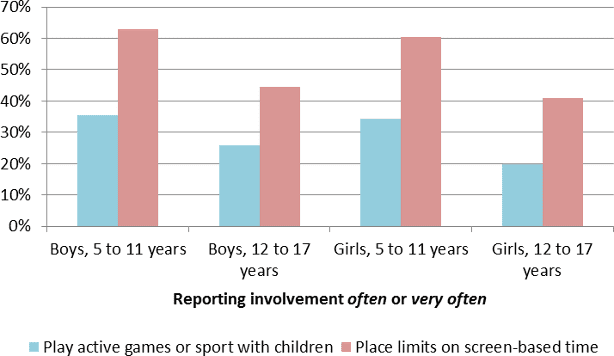
Source: 2022 Parent Survey of the Physical Activity and Sport Participation among 5 to 17 year olds, CFLRI
Parents of 5 to 11 year boys were more likely than those of 12 to 17 year olds boys to often or very often spectate or watch their child, whereas there were no differences between girls of these two age groups. Parents of 5 to 11 year old girls were more likely than 12 to 17 year old girls to often or very often encourage their child to play outdoors regularly, or to participate in active play instead of screen-based activities, whereas there were no age-related differences among parents of boys.
Figure 5: Parental involvement with children’s physical activities and sport by age and gender of child
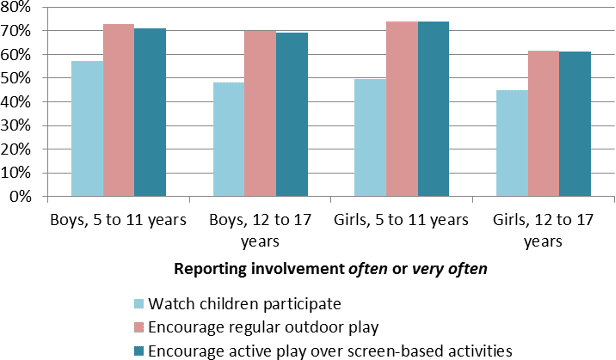
Source: 2022 Parent Survey of the Physical Activity and Sport Participation among 5 to 17 year olds, CFLRI
Although there were no differences between older youth and younger children by gender among parents who often or very often transport their child to places to be active, parents of both girls and boys aged 12 to 17 were more likely to not at all or rarely transport their child to activities, play active games or sport with their child, watch their child participate, or place limits on the amount of time that their child spends on screen-based activities compared to parents of 5 to 11 year old girls and boys.
Parents of 12 to 17 year old girls were also more likely than parents of 5 to 11 year old girls to not at all or rarely encourage their child to play outdoors regularly or to participate in active play instead of screen-based activities, however, these relationships were not significant among boys or else there was too few sample to report on significance.
Certain types of parental involvement were associated with socio-economic factors, such as household income or parental education level.
There were no significant differences in reported co-participation in active games or sport by household income. There were, however, considerable differences with the provision of transport by household income; for example, 43% of parents living in the lowest income households (<$60,000 per year) said that they often or very often transported their child to their physical activity or sport activities compared to 55% of parents living in the highest income households (≥$100,000 per year). The opposite relationship existed for parents who never or rarely transported their child; more specifically, 21% of parents living within the lowest income households reported this compared to 12% of those in the highest income households.
There was also a significant association between spectating and household income. Relatively more parents living in households with the highest incomes (≥$100,000 per year) indicated that they often or very often watched their child participating in sports or physical activities compared to those living in the lowest income households (<$60,000 per year). The converse relationship also existed, whereby a greater percentage of parents living in the lowest income households reported never or rarely watching their children participate compared to those living in the highest income households.
Figure 6: Parental involvement with children’s activities by household income
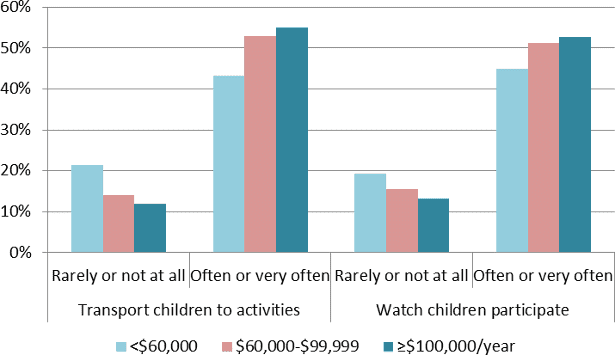
Source: 2022 Parent Survey of the Physical Activity and Sport Participation among 5 to 17 year olds, CFLRI
Parents with a university education were more likely than those with a secondary school education to transport their child to places so that they can participate in physical activity or sport often or very often, whereas parents with a secondary school education were more likely to report never or rarely transporting their child to activities compared to parents with a university education.
Figure 7: Parental involvement with children’s physical activities and sport by parental education level
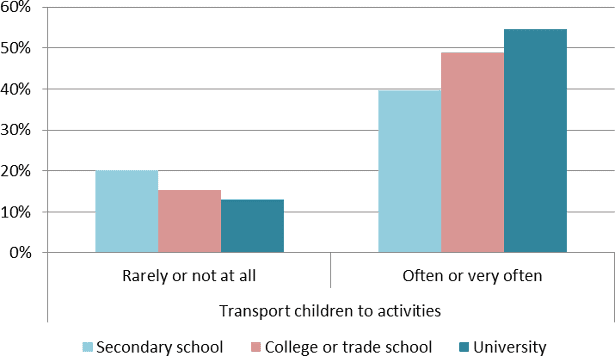
Source: 2022 Parent Survey of the Physical Activity and Sport Participation among 5 to 17 year olds, CFLRI
Parents who have immigrated to the country for some time between one and fifteen years were more likely to have reported that they often or very often play games or sport with their child compared to parents who were born in Canada.
Regional differences existed for several modes of parental involvement in physical activity and sport.
Compared to the national average, relatively fewer parents living in Quebec reported playing active games or sport with their child often or very often. Relatively fewer parents living in Quebec indicated that they often or very often transported their child to their physical activity or sport activities, whereas relatively more parents never or rarely transported their child to their physical activity or sport activities, when compared to the Canadian average. There were no significant relationships between watching their child participate in physical activity or sport with community size, or province/territory. Compared to the national average, slightly fewer parents residing in Newfoundland and Labrador reported that they often or very often encouraged their child to play outdoors regularly and to actively play over screen-based activities.
Production of this summary has been made possible through a financial contribution from the Government of Canada. The views expressed herein do not necessarily represent their views.


